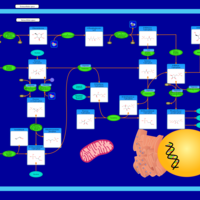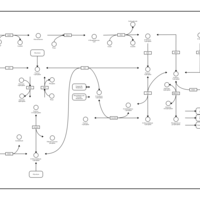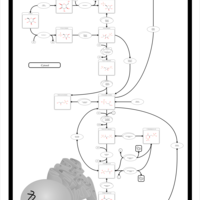| Description | beta-D-Glucose 6 phosphate (b-G6P) is the beta-anomer of glucose-6-phosphate. There are two anomers of glucose 6 phosphate: the alpha anomer and the beta anomer. Specifically, beta-D-Glucose 6-phosphate is glucose sugar phosphorylated on carbon 6. It is a very common metabolite in cells as the vast majority of glucose entering a cell will become phosphorylated in this way. The primary reason for the immediate phosphorylation of glucose is to prevent diffusion out of the cell. The phosphorylation adds a charged phosphate group so the glucose 6-phosphate cannot easily cross the cell membrane. b-G6P is involved in glycolysis, gluconeogenesis, pentose phosphate, and glycogen and sucrose metabolic pathways. beta-D-Glucose 6 phosphate can be generated through beta-D-fructose phosphate or alpha-D-glucose 6 phosphate (via glucose-6-phosphate isomerase) or beta-D glucose (via hexokinase). It can then be sent off to the pentose phosphate pathway which generates the useful cofactor NADPH as well as ribulose 5-phosphate, a carbon source for the synthesis of other molecules. Alternately, if the cell needs energy or carbon skeletons for synthesis then glucose 6-phosphate is targeted for glycolysis. A third route is to have glucose 6 phosphate stored or converted into glycogen, especially if blood glucose levels are high. |
|---|
| InChI Identifier | InChI=1S/C6H13O9P/c7-3-2(1-14-16(11,12)13)15-6(10)5(9)4(3)8/h2-10H,1H2,(H2,11,12,13)/t2-,3-,4+,5-,6-/m1/s1 |
|---|
| Pathways | | Name | SMPDB/PathBank |
|---|
| pentose phosphate pathway |    | | Glycolysis |    | | Gluconeogenesis |    | | Glycogen Storage Disease Type 1A (GSD1A) or Von Gierke Disease |    | | Trehalose Degradation |    | | Glucose-6-phosphate dehydrogenase deficiency |    | | Ribose-5-phosphate isomerase deficiency |    | | Transaldolase deficiency |    | | Glycogenosis, Type VII. Tarui disease |    | | Phosphoenolpyruvate carboxykinase deficiency 1 (PEPCK1) |    | | Fructose-1,6-diphosphatase deficiency |    | | Triosephosphate isomerase |    | | Fanconi-bickel syndrome |    | | Glycogenosis, Type IB |    | | Glycogenosis, Type IC |    | | Glycogenosis, Type IA. Von gierke disease |    | | Warburg Effect |    |
|
|---|